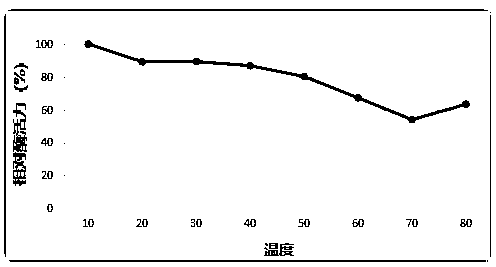Preparation and application of urechis unicinctus autolytic enzyme
A technology for the autolysing enzymes of the monocyclic spinyweed, which is applied in the direction of enzymes, peptidases, hydrolytic enzymes, etc., can solve the problems of the preparation and properties of the single-ringed spinypin autolytic enzymes that have not been reported yet, and achieve a good wall-breaking effect , reduce production costs, improve the effect of medical effects
- Summary
- Abstract
- Description
- Claims
- Application Information
AI Technical Summary
Problems solved by technology
Method used
Image
Examples
Embodiment 1
[0027] Embodiment 1: the preparation of a kind of autolysozyme of monocyclonic spinosa
[0028] 1. Preparation of the crude enzyme solution of the autolytic enzyme of the monocyclonic spinach:
[0029] (1) Thaw the discarded viscera of C. monoringensis stored frozen at -20--10°C at room temperature. After thawing completely, wash them with sterile water to remove impurities. Add PBS (0.1mol / l, pH 8.0) for homogenization, place at 4°C overnight, centrifuge at 5000r / min for 8min, and collect the supernatant;
[0030] (2) Add ammonium sulfate to the supernatant collected above to 20% saturation, place at 4°C for 4 hours; centrifuge at 8000r / min for 10 minutes, collect the supernatant, add ammonium sulfate to the supernatant to 70% Saturation, put it at 4°C for 4 hours; centrifuge at 8000r / min for 10 minutes, take the precipitate, add 10 times its volume of PBS buffer to the precipitate, and dialyze with a dialysis bag with a molecular weight cut-off of 8KD-14KD to obtain autolys...
Embodiment 2
[0035] Example 2: Evaluation of the lytic activity of autolysozyme for the body wall of C. monoringensis
[0036] Weigh the dried samples of the body wall of C. monoringensis, place them in six 1.5ml EP tubes, and divide them into the experimental group and the control group. Dilute the autolysozyme solution of C. monocircleum obtained in Example 1 to 1 mg / ml with PBS. 1ml of diluted autolyzed enzyme solution was added to the three tubes of the experimental group, and the same volume of PBS buffer solution was added to the control group, and the reaction was carried out in a water bath at 50°C. The body wall was taken out every 2 hours, blotted dry, and weighed. Wall weight data were collated and analyzed. The formula for calculating the degree of consumption is: consumption rate=initial weight-weight after reaction / initial weight×100%, and the results are shown in Table 1.
[0037] Table 1 Comparison of the dissolution effects of autolyses on the body wall of C. monocircleu...
Embodiment 3
[0040] Example 3 The thermostability evaluation of autolysozyme
[0041] The autolysozyme solution prepared in Example 1 was diluted to 1 mg / ml with PBS. Add 1ml of autolyzed enzyme solution to each of the four EP tubes, and heat them in water baths at 24°C, 80°C, 90°C and 100°C for 1 hour, and add 1ml of PBS to the EP tubes of the blank group. Add an equal weight of dry body wall of C. monoringensis to each tube, and react in a water bath at 55°C. After 1h, 2h, and 3h of the reaction, the body wall of the single-ringed weed was taken out respectively, the water was blotted, weighed, the body wall weight data was sorted out, and the consumption rate was calculated according to the formula recorded in Example 2. The results are shown in Table 2 .
[0042] Table 2 The thermal stability identification results of autolysozyme
[0043]
[0044]As shown in Table 2, the consumption rate of the body wall after 80, 90, and 100°C treatment for 3 hours decreased to 22.57%, 22.22%, ...
PUM
 Login to View More
Login to View More Abstract
Description
Claims
Application Information
 Login to View More
Login to View More - R&D
- Intellectual Property
- Life Sciences
- Materials
- Tech Scout
- Unparalleled Data Quality
- Higher Quality Content
- 60% Fewer Hallucinations
Browse by: Latest US Patents, China's latest patents, Technical Efficacy Thesaurus, Application Domain, Technology Topic, Popular Technical Reports.
© 2025 PatSnap. All rights reserved.Legal|Privacy policy|Modern Slavery Act Transparency Statement|Sitemap|About US| Contact US: help@patsnap.com



